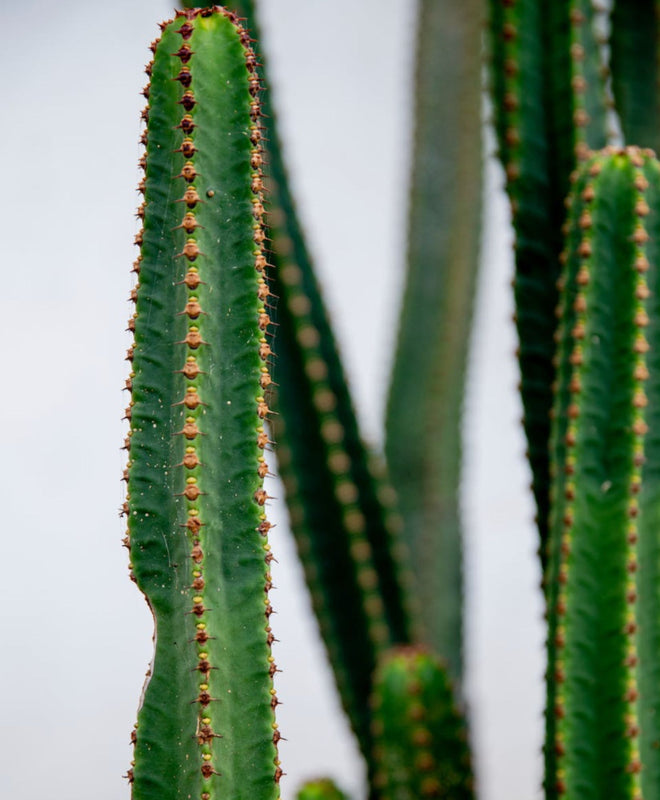
Care sheet: Cactus
Pas le temps de tout lire ? 👇Cliquez ici pour un résumé👇
Sommaire

The cactus is an easy-care and constant plant , which adds a touch of exoticism to our interiors. Depending on its variety, it is known to have sedative properties, but it is also renowned for its cosmetic benefits.
Maintenance sheet
They are found in various aspects, of all different shapes or sizes, their common point is however to adapt easily to our regions. But don't touch! They don't lack a certain spice...
Exposure
Depending on its layout, 6 hours of sunshine a day is often necessary.
Watering
Contrary to popular belief, water is as necessary for cacti as the air they breathe. Take this into account if you wish to see them flourish and prosper. They are never watered (once a month), all the land must be watered but the water must be able to run off very quickly. No cup under a pot therefore, and let its substrate dry out well between two waterings.
winter rest
It is to condemn him to more or less short term not to respect his needs during this period. Even if you want to pamper it, it is essential for most species to keep them dry and cold in winter. However, it is gently that you will have to reaccustom it to the sun and the temperate climate of spring.
Cultivation errors
Growing them indoors is hardly conducive to providing them with all the light they need, unless of course you have a veranda. When the plants lack it they wither, their shoots then become pale and thin. Outdoors , be sure to provide a sunny place but not too much, otherwise you risk seeing them “burn” from the first exposure to the sun’s rays. During the hottest hours of the day, protect them under a restful shade.
Diseases and prevention
Most cactus diseases can be prevented with proper maintenance.
- These are to be distinguished from parasites! Their appearance is most often directly linked to poor hydration , leading to cactus dryness or cases of rot .
Consequences: We observe the arrival of bacteria or fungi, in the form of shiny spots that will eventually kill it.
Solution: Ventilate the plant well but without drafts, avoid excessive watering and sudden drops in temperature.
- The most feared parasite of the Cactus is the cochineal , but they depend on its origins. Thus it can just as much be a victim of spiders, aphids, slugs...
Consequences: Like vampires, the tiny insects feed on its sap, even in its most intimate parts.
Solution: Regularly examine your plants, and isolate those that seem suspicious as soon as possible.
How to repot a Cactus?
Planting the Cactus: The propagation of the Cactus is done by sowing and cuttings, but it is also possible to proceed with a graft. The germination rate is a function of the freshness of the seeds, to be purchased or taken from your plants. Remember to bring gloves for any repotting, if necessary get help from someone who will hold the pot during the operation.
1. The substrate should preferably be mineral and prefer spring, it is the best time to sow. If you have several varieties, arrange them at the rate of only one per pot, at the risk of having to install separators in a large container. Identify the origin and the name of the plant, otherwise you will have difficulty distinguishing them all.
2. Keep everything well moistened until you see the seedlings appear. Once out, consider airing them out, so that the soil can dry out. You have the option of adding a fungicide for watering. As for the latter, it must be dosed carefully to avoid rotting, which is just as much to be feared as drought.
3. Use a substrate similar to that of the adult cactus, thin but not too thin so that its roots can settle in easily. From the following spring the seedlings can be repotted. Note that sowing allows, for the majority of species, to obtain plants that will reach between 1 and 3 cm in diameter in 18 months.
Good to know
Cuttings consist of separating an end of the plant, cutting it before rooting it to give birth to a new shoot. This is particularly easy if you are dealing with cacti that produce small shoots at their base. Take them when the cactus is growing, a simple clean sharp knife and you're done!
Note: You have the choice between many forms of cactus. If as a precaution it is better to keep them frost-free, dry and hydrated, some can withstand temperatures down to -10°C. Others are more fragile, it's up to you!
POUSSE, the plant architecture agency that reconnects your spaces in Lyon, Paris and Bordeaux to nature.
Contact us: bonjour@pousse.fr
Written by aline jneid